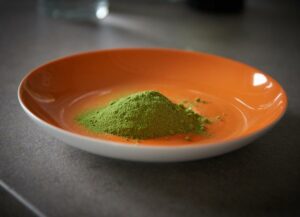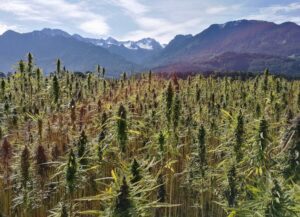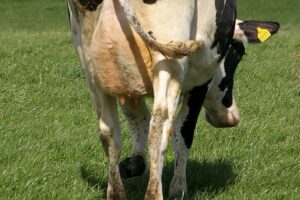Mercedes González & Fernando Diaz
Ruminants have a highly developed and specialized type of digestion, which allows them to obtain energy more efficiently from fibrous foods compared to other herbivorous animals. To maintain their health and maximize their production cows, as well as other ruminants, need forage in their rations that maintain a stable and healthy rumen environment.
Sources of fiber of stable and known composition are usually used in dairies to formulate rations as homogeneous as possible. High quality forage is often used, with a composition that depends on products available in that particular geographic region, but that in general are usually grasses (festuca, ryegrass, etc.), legumes (alfalfa, etc.), or cereals (corn, wheat, barley, and many others). Their presentation can also vary being either fresh or preserved (i.e. silage, hay).
The use of agricultural coproducts, however, has long been linked to the supply of fiber to dairy cows. They are an inexpensive source often of good or acceptable nutritional value, and given the growing impact of climate change in recent years, they are a great ally to the agricultural sector to help reduce the environmental impact, as they enter into the concept of a circular economy.
Many coproducts from human food production are usually discarded. It is estimated that approximately one-third of the food produced for human consumption is wasted (representing 1.3 trillion tons per year globally). As this has significant environmental impact, the need to implement management strategies based on Reducing, Reusing and Recycling (‘the three R’) is increasingly emphasized.
Taking advantage of these coproducts for dairy cow feeding, which would otherwise be wasted, means contributing in a very intense and very positive way to mitigate the adverse effects of pollution and waste generated by this industry effectively utilizing resources.
Utilization of fresh salad industry coproducts
A large group of coproducts from the human food industry are vegetable crops intended for fresh packaged salads. They consist of a wide variety of vegetables to be consumed in supermarkets that are grown, washed, cut, processed and packaged within 24 hours.
Most of them include ingredients such as lettuce, arugula, cabbage, cauliflower, tomato, chicory, parsley, chard, celery, escarole, endives, zucchini flowers, carrots, broccoli, spinach, potatoes, onions, mushrooms, peaches, mangoes, melons, and oranges.
Their processing from the time they are collected until they are sold in supermarkets is complex and needs to be done carefully. They are plants with intrinsically high-water content (increased with washing), they deteriorate easily with the cutting of the plant and subsequent blending to make the salads and have a very short expiration date. Therefore, coproducts also have a very short shelf life and can be easily damaged.
The usable remains for animal feed are stems and leaves that are not included in salads either because they are too fibrous, or in the case of fruits those that are bruised and do not look pleasant to the consumer, and are thus separated in the processing plant.
This table shows the nutritional composition of the most common ingredients of vegetables used in salads (% fresh matter):
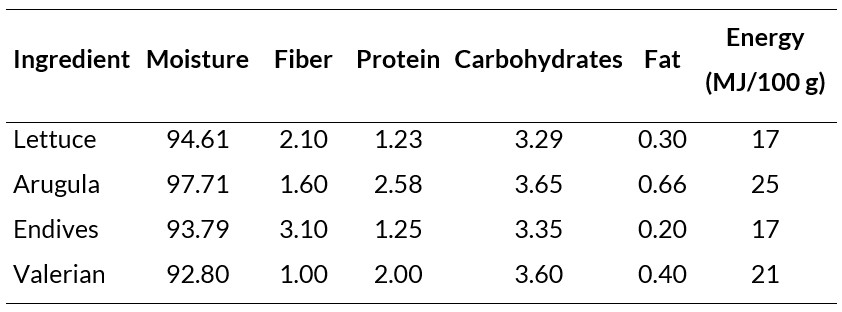
One study examined the nutritional composition of coproducts as ruminant feed from a salad processing plant (Pinotti et al., 2020). The authors extracted various samples of salad vegetable crop waste and analyzed the nutrients of greatest interest.
This other table shows the nutritional composition of salad coproducts compared to fresh forages (grasses or legumes) used in standard rations formulated for ruminants:
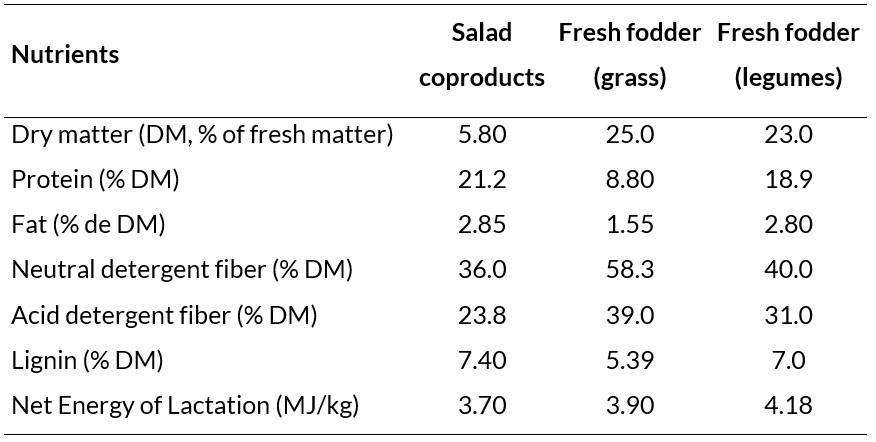
The protein content is high in salad coproducts
One of the advantages of including salad coproducts in the ration is that their high moisture content provides them high palatability and volume, so they have a positive effect on the rumen walls and stimulate intake.
With regards to protein, it was observed that the content is high in salad coproducts, but what not clear was whether it comes from true protein or non-protein nitrogen. These coproducts are high in nitrogen (in general, green vegetable shoots are usually very high in nitrogen due to their high metabolic activity resulting from their rapid growth), but if it is not properly balanced, they can have a negative effect on the ration.
Highly soluble proteins should be accompanied by an adequate supply of carbohydrates to prevent meteorism or lameness in cows. This study did not evaluate the amino acid content of salad coproducts, the digestibility of this protein, or whether there was any fraction of bypass protein.
The fiber content of salad coproducts is high, although lower compared to fodder, probably due to the stage of the plant’s growth. This can affect digestibility, as they can be a highly digestible source of fiber.
Salad coproducts are also an important source of micronutrients, such as vitamins C, A and E, and the B complex, as well as minerals and polyphenols, carotenoids and glucosinolates. However, more studies are still needed to know its effects on the production or reproductive parameters of animals.
Because there is still not a lot of literature on the nutritional composition of these coproducts, it would be interesting to move forward with research to see what effects they would have on animal dry matter intake and its resultant production.
Conclusion
In conclusion, salad coproducts seem to be good ingredients to add to rations, mainly because of their environmental impact, and because they could constitute a part of the rations fully mixed, either fresh or reserved as silage or hay for an easier storage (especially because of their high moisture content).
They could be a good alternative to some sources of forage and are a good example of the circular economy concept for the use and recycling of raw materials. However, further research is still needed to better understand their nutritional composition, digestibility and impact on animal production.
Reference
Luciano Pinotti, Michele Manoni, Francesca Fumagalli, Nicoletta Rovere, Alice Luciano, Matteo Ottoboni, Luca Ferrari, Federica Cheli, Olivera Djuragic. Reduce, reuse, recycle for food waste: a second life for fresh-cut leafy salad crops in animal diets. Animals. 2020 Jun; 10(6): 1082-1092.
© 2020 Dairy Knowledge Center. All Rights Reserved.



